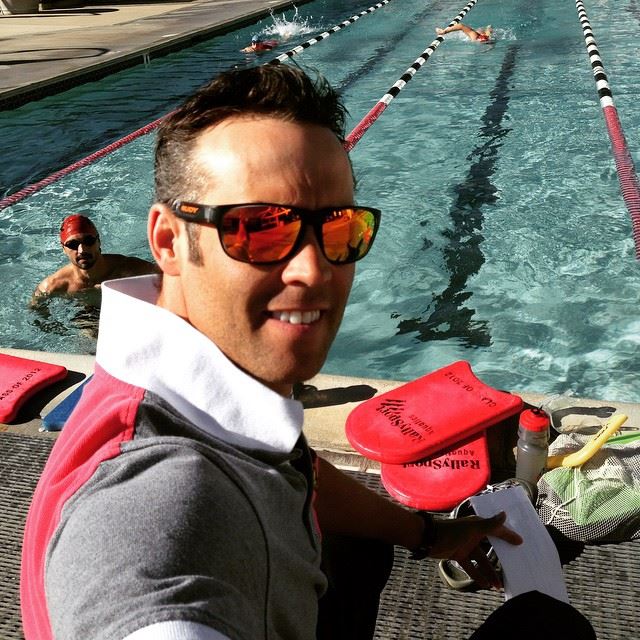
09 Mar “Tri” Pro Triathlete James Hadley’s Tips for A Super Swim
It’s officially triathlon season and the race options are endless! No matter what distance you plan on racing this season, or what your level of ability may be, take some tips from pro triathlete, and super-swimmer, James Hadley. Growing up as an elite swimmer in England, Hadley is not only a naturally talented swimmer, but spent endless hours in the pool and open water to help him stay in the lead pack on race day. As a pro and a coach, Hadley lets us in on what it takes to have success in the water.
How and when did you first get into swimming?
I started swimming at the age of eight because I had copious amounts of energy that my parents struggled to cope with. My Auntie suggested taking me to swim lessons to burn off a little energy. I loved going to the local pool as, at the time, it was really only on special occasions that we’d ever go swimming, so to actually join the swim team and go on a regular basis just seemed like heaven to me.
My first session started in the small pool, but the instructor realized immediately that I would benefit more by being in the big pool doing widths. This is where my technique for swimming started to develop. I was always told from the start to swim with high elbows out of the water (kind of like finger drag style) and also the old “S shape” under the water. I took to this straight away and continued moving up through the “widths ranks.”
Eventually I reached the top level of swim practice at the age of 10. My coach was a guy we called “Uncle Sam,” who was my all time favorite swim coach and really helped elevate my technique and performance. After many years of training and competing around the country, I qualified to train and race for a county National swim team. The 2-a day training regime was exhausting, but we felt this was something that I needed if I wanted to become an even better swimmer.
How did you learn to swim with proper technique?
I learned at Weston-Super-Mare swimming club where Uncle Sam would hit us on the head with a stick with a squash ball attached to it and tell us to do press-ups if we got the stroke he taught us wrong. He was so scary and aggressive that lots of kids refused to swim in his lane, and even cried if forced to do so, but not me, I loved his style of coaching. He was an old school technician so I had to make some finer adjustments throughout the years, especially for open water, which I taught myself through trial and error and lots of swimming.
To help other triathletes, what are some of the techniques needed for efficient swimming in training?
Everyone is so different, so I think a lot of triathletes need to find out what kind of a swimmer they are and do they float or not. We did a test back in the day where we laid on our backs in the water for 5 minutes! That basically told the us that I was a negative buoyancy swimmer, which meant I would rely more on my kick efficiency to keep a good body alignment than my friend who would utilize his pull more. This meant he would need a higher arm cadence than me and I would do a lot of kick sets to ensure that I wouldn’t fatigue when I race and engage my kick furiously. Also, body position is absolutely critical. Your body needs to be as straight, but relaxed as possible in the water. If I swim with my head up at all, or at a 45+ degree angle, I get tight in the neck and shoulders, so I practice keeping my head down to look at the bottom of the pool. This keeps my head in a neutral position, which helps me to relax everything and keep my hips and legs higher in the water. A neutral body position is always more comfortable for long swims, hence, less fatigue.
What are some swimming tips when it comes to racing in open water amongst other triathletes?
Before you start, look out in the distance where you can see land and line up the end or turn point buoy to a landmark you can see above it in the distance. This way when you can’t see the buoys, you can see the landmark and prevent yourself from wasting time looking up every two seconds or swimming in zigzags. To view the landmark, lift your head forward then to the side to breathe in one motion so you don’t slow down. Practice taking a normal breath with a very quick glance forwards before hand. I always put some liquid soap on my finger and wipe it on the inside of my goggle lens then lightly rinse it out. This will clear your goggles and totally eradicate the chance of them fogging up.
What are some of the biggest mistakes triathletes make when it comes to the swim portion of a triathlon?
A big mistake that some beginners make is showing up unprepared or too confident in regards to the dangers of open water swimming. They assume because they can swim in a pool that they’ll be just as good in dark, dirty, murky open waters, which isn’t true. It’s easy to get disorientated and confused in this type of environment, so you should practice in a wetsuit before hand. You’re always better off to show up more prepared than necessary than not at all. Another big mistake beginner triathletes make in the swim is to breathe every 3 strokes! The amount of age-group athletes that tell me they try to swim bi-laterally in a race was astounding. I tell them it’s almost like trying to run at race pace whilst holding your breath for three seconds after each time you breathe! You should breathe every two strokes as oxygen is your best friend!
What are some of the swim “toys” triathletes should look to incorporate into their swim training and how does each one help?
Swim toys are great in order focus more specifically on a certain aspect you might need to improve. Paddles can be used for proper technique and great for improving shoulder and lat strength. Fins for the same purpose, but obviously focus on the legs & hip flexors. Pull buoys are used to help maintain correct body posture whilst swimming with arms only and limited leg movement. The band around the ankles is a more advanced version of the pulling drill as your ankles are tied together by a band. This way everything other than your hips and arms are prevented from moving properly and from giving you any help or propulsion at all. You really need to rely on strength and rotation from your hips and obliques to get you through the water with good technique. Some athletes have taken to using a snorkel to help focus on perfect technique whilst swimming because it eliminates the hardest part of the stroke…breathing. The swimmer can ‘iron out’ little discrepancies in their technique to attain perfect form and re-groove the ‘normal’ feeling of their faulty stroke to having a normal feeling with a correct stroke.
As a coach of amateurs, how many times a week should triathletes be in the pool and what are the different types of workouts they should incorporate into their training?
The amount a triathlete should swim a week is very individual. I try to schedule all of the athletes I coach to swim at least 3 times a week, so I can incorporate one aerobic long swim, one threshold race pace swim, and on some weeks a fast VO2 day that will have them swimming maximal efforts. I think everyone needs a holistic approach to swim training. You can’t just swim one pace or the same distances each day. Mix it up with sets similar to 3x 800’s one day, 10x 200’s on another with pace differences, 5x 100 max VO2 efforts the next and a strength band/buoy and kick set on others. Cover all energy systems to produce an overall balanced swim fitness. Make sure to work on your kick also. This is the most neglected part of a triathletes swim program, but when it comes to racing, the first thing we do when the gun goes off is kick like heck for the first 400 meters! It’s why triathletes blow up and struggle for the remainder of the swim.
If someone is going to race their first triathlon, should they look for a lake swim vs. an ocean swim and should they practice in a wet or speed suit?
For their first open water swim this again is down to personal preference. I would guess swimming in a lake would be more comfortable for them. Although in reality the sea swim can add extra buoyancy due to the salt water, but at the same time would be much scarier due to really being out in the open and not surrounded by as much land.
Yes, definitely practice in all the gear that they might have to use. You can never practice enough! For the start of the race, I like to start on the outside edge of the group to stay out of the way of too much contact, which is really fatiguing if you get into an ongoing scrap on your way down to the first buoy. Relax out to the side, take your time, go your own speed and then drift in toward the middle for a nice draft once the pack has thinned out.
What are your ultimate tips for “surviving” a triathlon swim?
Beginners should definitely swim in a lake a few feet from the edge of the embankment so they can grab hold. or receive help, straight away if they get into any difficulty. This will massively help with their confidence and can gradually start to venture out into deeper or rougher waters.
4 Fun Facts About Hadley:
1. My favorite triathlon swim course is… Hands down, Ironman 70.3 Cozumel! The water is beautifully warm and crystal clear. I could see the sea life swimming beneath me the entire way round. I pretty much enjoy all non-wetsuit swims though.
2. My favorite swim workout is… One of my favorite main sets is 6x 100 max out VO2 efforts with a 4 minute rest. I love going fast and even though this one is short it will really kick your butt!
3. To improve your swim you…have to swim, swim and swim. However, every swim needs to have a purpose whether it’s a threshold set or a scheduled recovery swim. Everything has a place, and the more holistically you view the training variety the better. Get strong, get fit.
4. Everyone that knows me or swims with me would bet their entire savings that my favorite swim tools are the paddles! I love them so much that I bring them to every session and smash it every time!







No Comments